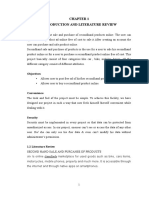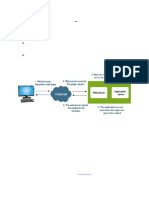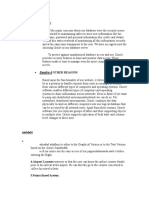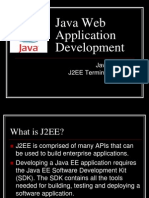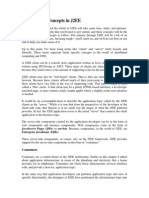Section Ii: Java Servlets
Uploaded by
nathdmcaSection Ii: Java Servlets
Uploaded by
nathdmcaChapter 6.
SECTION II: JAVA SERVLETS
Introduction To Java Servlets
Over the past few years, there have been some incredible changes in the way computers are
used. Large and cumbersome commercial applications, run on the desktop, are gradually
losing their significance. With the rapid spread and adoption of the World Wide Web as a
network without geographical boundaries, information and business applications need to be
accessed and run from virtually anywhere.
The web pages are not static anymore instead they are used for delivering services such as
displaying bank account details, bank transactions, booking tickets, weather reports, news
headlines and so on. Web pages have never been more capable of delivering dynamic content
with the greatest of ease, than today.
In such a scenario, the demand for faster, lighter, robust, scaleable, commercial applications
that can deliver across the Internet has risen exponentially.
Today there are several powerful tools to work with. In the past, if a database-driven
application was required this was limited to writing Common Gateway Interface [CGI]
scripts to process form data and return results. CGI has served the purpose of adding
interactive and dynamic content to a Web site in the past, it's most serious drawback being its
lack of scalability and platform dependence.
Scripting Internet delivered, commercial applications using Active Server Pages [ASP] and
PHP have helped simplify Web application development. Such programming environments
have provided developers with simple, tried and tested, methodologies to create robust,
scalable, Web enabled commercial applications.
To address the specific requirements of building scalable, extensible, portable Server-side
solutions for Internet based commercial applications, Sun Microsystems has developed a
technology called Servlets, crafted using Java.
Java Servlets are efficient, due to an intuitive and automated threading model in which each
request is handled by a new lightweight thread. Servlets are also platform [i.e. hardware]
independent, they run using a set of standard interfaces [that make up the Servlet engine] and
a Java Virtual Machine [JVM]. It is the JVM that is built to run on a specific hardware
platform. Thus if a JVM exists for a specific hardware platform any Servlet crafted and
validated on any other hardware platform will run successfully.
Java Server Programming For Professionals
Page 77
Java Servlets actually provide an object-oriented and extensible middle tier for Web Server
based applications. Servlets can access all of the enterprise Java APIs like JNDI, JDBC, RMI
and Enterprise JavaBeans and so on.
This chapter will introduce and examine Java Servlets from their conceptual and code spec
angles together with their related Server-side Java technologies. This should expose exactly
how Server-side Java can act as a strong dependable code underlay in developing N-tier
applications. Applications based on browser based client code accessing business logic and
data services through Servlets run on a Java enabled Web server.
What Is A Servlet
A Servlet is a Server-side java program that is platform independent. Servlets, written in Java
dynamically extend the functionality of any Java enabled Web server. Web servers generally
cannot talk to databases. Hence, a Web server alone cannot dynamically create web page
content using data held in a database table. Even if there is a large amount of legacy data in a
database table, this information cannot be made accessible to public via the Web server,
Internet and Browser combination.
This is where Servlets, [i.e. basically Java .class files] help extend the functionality of a Web
server. Web servers use the Servlet's ability to access a database table, extract table data, and
convert this data into a format acceptable to a Web server for delivery to a client's Browser via
the Internet.
Servlets are written in Java. Java is a very portable language that obeys rules that permit
Servlets to run on a standard framework [i.e. the JVM]. They provide a means to create
sophisticated Web server extensions and are independent of operating system and hardware
platform.
Even though Servlets are written in Java, their clients may not necessarily be written in Java.
Servlet clients [i.e. an application that consumes the output of a Servlet] can be written in any
desired language. This simply means that Servlets are used in the middle tiers of distributed
application systems. Servlets can in turn be clients to other services, which are written in
some other language.
Servlets are not tied to a specific client-server protocol but they are most commonly used with
HTTP. The word Servlet is often used to represent HTTP Servlet.
Since Servlets run within a Web server's namespace they do not display a graphical interface
to a user. A servlet's work is done behind the scene i.e. working with a Web server. Only the
results of a servlet's processing [table data converted to suitably formatted HTML] are
returned to a client's browser.
Java Server Programming For Professionals
Page 78
A Servlet Container [i.e. the Servlet Engine] provides the runtime environment in which a
Servlet executes. The Servlet engine manages the life-cycle of Servlets from the moment they
are spawned until they are destroyed. The Servlet engine exposes an API based on the
version of the Servlet specification that it implements.
Servlets are supported by several Web servers such as Apache, Netscape, Microsoft IIS and
others.
HINT
Servlets are the Web server side counterpart to Applets. Applets run only on the
client side within a Java enabled Browser.
Applets are Java application components, which are downloaded, on demand, run
in a Java enabled client Browser and thus participate in the commercial
application, which needs them.
Why Servlets
! Are loaded into memory once and run from memory thereafter
! Are spawned as a thread, not as a process
! Are a powerful object-oriented abstraction of HTTP
! Are portable across multiple Web servers and platforms
! Are simple to design and implement
! Are tightly integrated with the Web server
! Service client requests efficiently
! Run within the secure and reliable scope of a Java Virtual Machine [JVM]
! Obey the rules of a standard Servlet API
! Return vanilla HTML to the requesting Browser
! Are robust, scaleable, secure CGI Replacement
! Provide direct Database Access using native and ODBC based Db drivers
! Being on the Server-side provides code protection
! Are supported by several Web servers
6. Introduction To Java Servlets
Page 79
What Can Servlets Do
A Servlet is a small, self-contained, portion of code that is executed at the Web Server in
response to an HTTP request from a client's Browser. Servlets can do the following:
! Servlets can be used as a plug-in, that features a search engine or semi-customized
applications such as web-based banking or inventory systems
! A Servlet can be used to process data POSTed over HTTP(S) using an HTML form and
apply appropriate business logic
! A Servlet can handle multiple requests concurrently and these requests can be
synchronized to support systems allowing collaboration between people
! Servlets can forward requests to other Servers and Servlets. This allows them to be used
to balance load among several servers that mirror the same content
! Servlets can maintain and track sessions (either by URL rewriting or cookies). Servlets
clean up the session precisely when a session is terminated, either by logging off or by a
time-out
! Servlets can pass data between themselves
! Servlets can be used to serve as the HTTP speaking middle tier between any kind of thin
client and large enterprise services being made available via EJB's
Servlets V/s CGI
! Java Servlets are more efficient, easier to use, more powerful, more portable and cheaper
than traditional CGI and many alternative CGI-like technologies such as Perl
! With CGI, a new process is started for each HTTP request. The initialization process of
the CGI program takes a longer time than its execution time
With Servlets, the Java Virtual Machine stays up in the memory between requests and is
handled by a lightweight Java thread, not a heavyweight operating system process
! If there are N simultaneous requests to the same CGI program, then the code for the CGI
program is loaded into memory N times
With Servlets, however, there are N threads but only a single copy of the Servlet class
! Servlets can be used for optimizations such as caching previous computations, keeping
database connections open, than a regular CGI program
! Servlets have an infrastructure for automatically parsing and decoding HTML form data,
reading and setting HTTP headers, handling cookies, tracking sessions and many other
such utilities
With these utilities, Java Servlets do several things that are difficult with regular CGI
Java Server Programming For Professionals
Page 80
! Servlets can talk directly to the Web server, whereas CGI programs cannot. Servlets can
share data among each other, making database connection pools easy to implement
! Servlets are written in Java and follow a standardized API. Servlets written for I-Planet
Enterprise Server can run virtually unchanged on Apache, Microsoft IIS or WebStar. This
cannot happen with CGI
! Servlets are supported directly or via a plugin on almost every major Web server
How Are Servlets Created
Servlet code spec can be written using any ASCII editor. The code spec crafted is saved to the
hard disk using <filename>.java. Notepad is an excellent example of a simple, no frills ACSII
editor. <filename>.java is the Servlet's source file. This must be compiled using the Java
compiler [i.e. javac], which is part of the Java Development Kit [JDK].
After compilation, the source file will be converted to Java byte code and saved to the hard
disk as <filename>.class. This is the Java .class file, which will run in a Java Virtual Machine
[JVM] anywhere.
Where Are Servlets Run
A Servlet runs behind the scene [without a Graphical Interface] on a Web server. Servlets
always work in conjunction with the Web server software. Servlets provide a framework for
creating applications that implement a request / response paradigm which is bound to the
Web server.
For example, a browser sends a request to the Web server for HTML page content. The Web
server will forward this request to a Servlet, via its extender software. At this point the Servlet
will process the request [access a database, table or run some other process] construct an
appropriate response [usually formatted HTML], which is returned to the requesting Browser
via the Web server.
What Do Servlets Look Like
Servlets are based on request-response paradigm where requests are accepted and responses
are generated. Servlets implement the Servlet interface either by extending a generic or an
HTTP-specific Servlet interface implementation.
6. Introduction To Java Servlets
Page 81
HINT
An interface is like a class with the following restrictions:
1. All its methods must be an abstract instance methods and no static methods
are allowed
2. The variables defined in an interface must be a constant [i.e. static final]. The
values of these variables need not be declared at compile time, but some
computation can be done at class load time to compute the values. The
variables need not be just of type int or string, they can be of any type
3. The static initializer methods cannot be defined in an interface. They should
be defined outside the interface
The following is a Servlet code spec template:
import java.servlet.*;
public class MyFirstServlet extends HttpServlet
{
public void service(ServletRequest request, ServletResponse response) throws
ServletException, IOException
{
...
}
...
}
The service() method has two parameters named Request and Response. These parameters
encapsule the data sent by the client, provide access to parameters and allow Servlets to
report status, including errors.
When MyFirstServlet.java is compiled using javac, the result of the compilation is a file
MyFirstServlet.class.
How Are Servlets Run
In a production environment, Servlets are run using Web servers.
The Servlets API is a standard framework, used to write Servlet code spec. Servlet Engines
provide Runtime Environment to Servlets. As long as the Servlet engine exposes the required
Servlet API, the developer need not worry about how PORTABLE the Servlet could be.
It is the Servlet Engine that satisfies the project's requirements. They come as standalone and
add-on.
Java Server Programming For Professionals
Page 82
Servlets are supported by nearly all Web servers from Apache to Zeus. Some Web servers
support Servlets right out of the box. These kind of Web servers are called as a Standalone
Servlet Engine. Other Web servers require a third-party plug-in to support Servlets. These
kinds of Web servers are called an Add-on Servlet Engine.
Standalone Servlet Engines
A standalone Servlet engine is a server that includes built-in support for Servlets. Such an
engine has the advantage that everything works right out of the box. One disadvantage,
however, is that one has to wait for a new release of the Web server to get the latest Servlet
support.
A Few Examples of Standalone Servlet Engines:
! Tomcat Server from Project Jakarta
! IBM's WebSphere Application Server
! BEA Weblogic Application Server
! Oracle Application Server
! Jetty Server
! iPlanet [Netscape] Web Server Enterprise Edition
Add-On Servlet Engines
An add-on Servlet engine functions as a plug-in to an existing server. It adds Servlet support
to a Web server that was not originally designed with Servlets in mind.
Add-on Servlet engines have been written for many Web servers such as:
! Apache
! Netscape's FastTrack Server and Enterprise Server
! Microsoft's Internet Information Server and Personal Web Server
! Lotus Domino's Go Webserver
! StarNine's WebSTAR
! Apple's AppleShareIP
This type of engine is especially beneficial when a new release of the Servlet Engine is
available. One does not need to wait for new release of the Web server.
A Few Examples of Add-on Servlet Engines:
! Tomcat Server from Project Jakarta
6. Introduction To Java Servlets
Page 83
! Java-Apache Project's JServ Module
! Allaire's JRun Web Server
! New Atlanta's ServletExec
! Enhydra
! Servertec's iServer
! Unicom's Servlet CGI Development Kit
! Gefion Software's WAICoolRunner
Architecture Of A Servlet
Having answers to the following questions:
! What is a Servlet?
! Why Servlets?
! What Can Servlets Do?
! Servlets v/s CGI?
! How are Servlets created?
! Where are Servlets Run?
! What do Servlets look like?
! How are Servlets run?
It's time to actually answer the most important question. That is the Architecture Of A
Servlet, which is explained, in the following chapter.
Java Server Programming For Professionals
You might also like
- Introduction To Developing Web Applications - NetBeans IDE Tutorial PDF100% (1)Introduction To Developing Web Applications - NetBeans IDE Tutorial PDF8 pages
- 4.airport Layouts:wayouts So That The User Can Know The Airline Counter DetailsNo ratings yet4.airport Layouts:wayouts So That The User Can Know The Airline Counter Details16 pages
- 4.airport Layouts:wayouts So That The User Can Know The Airline Counter DetailsNo ratings yet4.airport Layouts:wayouts So That The User Can Know The Airline Counter Details16 pages
- 1.1 A Brief History of The Web: Java ServletNo ratings yet1.1 A Brief History of The Web: Java Servlet13 pages
- 4.airport Layouts:wayouts So That The User Can Know The Airline Counter DetailsNo ratings yet4.airport Layouts:wayouts So That The User Can Know The Airline Counter Details16 pages
- 1.dynamic Bandwidth Calculation:: Web ServerNo ratings yet1.dynamic Bandwidth Calculation:: Web Server16 pages
- Online Airline Ticket Reservation SystemNo ratings yetOnline Airline Ticket Reservation System19 pages
- PPT Unit 3 J2EE and Web Development-265689No ratings yetPPT Unit 3 J2EE and Web Development-26568932 pages
- Java Web Application Development: Java EE 5 J2EE TerminologiesNo ratings yetJava Web Application Development: Java EE 5 J2EE Terminologies16 pages
- Internet and Web Technology B.E. 6th Sem I.T.No ratings yetInternet and Web Technology B.E. 6th Sem I.T.203 pages
- Producer and Consumer: Java EE Enterprise EditionNo ratings yetProducer and Consumer: Java EE Enterprise Edition10 pages
- Cavaserver Pages (JSP) Technology Allows You To Easily Create Web Content That Has Both StaticNo ratings yetCavaserver Pages (JSP) Technology Allows You To Easily Create Web Content That Has Both Static3 pages
- Features and Concepts in J2EE: ContainersNo ratings yetFeatures and Concepts in J2EE: Containers12 pages
- Techguruspeaks.com Home Advanced Java ProgrammingNo ratings yetTechguruspeaks.com Home Advanced Java Programming271 pages
- IBM Websphere Application Server Interview QA: WebserverNo ratings yetIBM Websphere Application Server Interview QA: Webserver3 pages
- Websphereinterview 100725022705 Phpapp02No ratings yetWebsphereinterview 100725022705 Phpapp02193 pages
- ITMD 566 Assignment Kedar Naresh Naik A20389660No ratings yetITMD 566 Assignment Kedar Naresh Naik A203896601 page
- Unit 6 - Servlets and Java Server Pages (JSP)No ratings yetUnit 6 - Servlets and Java Server Pages (JSP)111 pages
- Java Web Development: Java Unleashed: Crafting Enterprise-Level SolutionsFrom EverandJava Web Development: Java Unleashed: Crafting Enterprise-Level SolutionsNo ratings yet
- ASP.NET For Beginners: The Simple Guide to Learning ASP.NET Web Programming Fast!From EverandASP.NET For Beginners: The Simple Guide to Learning ASP.NET Web Programming Fast!No ratings yet
- Question Bank For Internet Programming Regulation 2013100% (1)Question Bank For Internet Programming Regulation 20137 pages
- Cspe33 - Web Technology Assignment # 2 Programs Using Java ServletsNo ratings yetCspe33 - Web Technology Assignment # 2 Programs Using Java Servlets3 pages
- Introduction To Web Programming: IT 533 Lecture Notes Gülşen DemirözNo ratings yetIntroduction To Web Programming: IT 533 Lecture Notes Gülşen Demiröz42 pages
- UNIT 1 Questionbank Final Web TechnologyNo ratings yetUNIT 1 Questionbank Final Web Technology17 pages
- Dbms Project Report (Blood Bank Management System)No ratings yetDbms Project Report (Blood Bank Management System)73 pages
- Introduction To Developing Web Applications - NetBeans IDE Tutorial PDFIntroduction To Developing Web Applications - NetBeans IDE Tutorial PDF
- 4.airport Layouts:wayouts So That The User Can Know The Airline Counter Details4.airport Layouts:wayouts So That The User Can Know The Airline Counter Details
- 4.airport Layouts:wayouts So That The User Can Know The Airline Counter Details4.airport Layouts:wayouts So That The User Can Know The Airline Counter Details
- 4.airport Layouts:wayouts So That The User Can Know The Airline Counter Details4.airport Layouts:wayouts So That The User Can Know The Airline Counter Details
- Java Web Application Development: Java EE 5 J2EE TerminologiesJava Web Application Development: Java EE 5 J2EE Terminologies
- Cavaserver Pages (JSP) Technology Allows You To Easily Create Web Content That Has Both StaticCavaserver Pages (JSP) Technology Allows You To Easily Create Web Content That Has Both Static
- IBM Websphere Application Server Interview QA: WebserverIBM Websphere Application Server Interview QA: Webserver
- Java Web Development: Java Unleashed: Crafting Enterprise-Level SolutionsFrom EverandJava Web Development: Java Unleashed: Crafting Enterprise-Level Solutions
- ASP.NET For Beginners: The Simple Guide to Learning ASP.NET Web Programming Fast!From EverandASP.NET For Beginners: The Simple Guide to Learning ASP.NET Web Programming Fast!
- Question Bank For Internet Programming Regulation 2013Question Bank For Internet Programming Regulation 2013
- Cspe33 - Web Technology Assignment # 2 Programs Using Java ServletsCspe33 - Web Technology Assignment # 2 Programs Using Java Servlets
- Introduction To Web Programming: IT 533 Lecture Notes Gülşen DemirözIntroduction To Web Programming: IT 533 Lecture Notes Gülşen Demiröz
- Dbms Project Report (Blood Bank Management System)Dbms Project Report (Blood Bank Management System)


